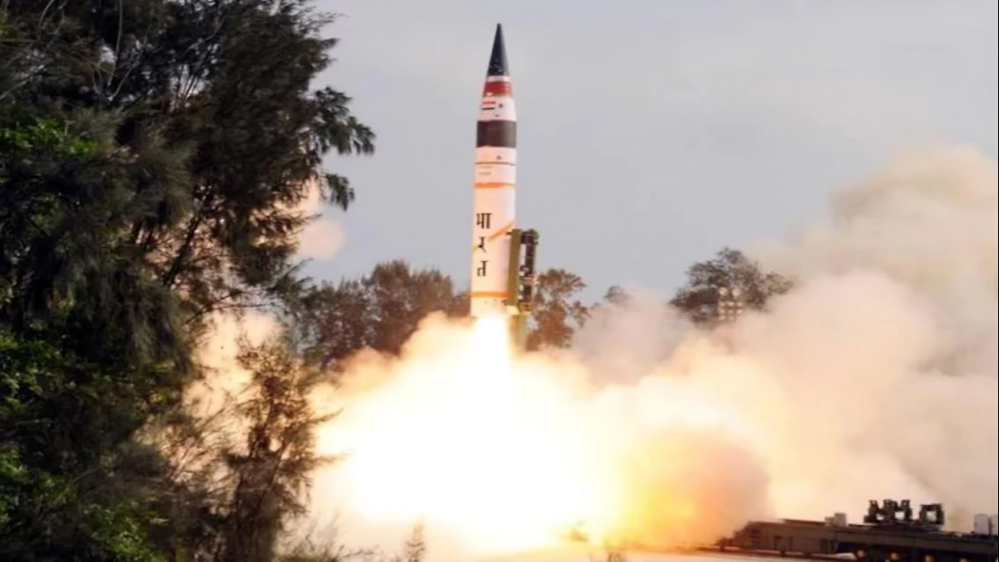India Successfully Conducts Maiden Test of Agni-V MIRV Missile
In a significant stride towards bolstering its strategic deterrent capabilities, India successfully conducted the maiden test of its indigenously developed Agni-V MIRV (Multiple Independently Targetable Re-entry Vehicle) missile on March 11. Codenamed Mission Divyastra, the test marked a crucial advancement in India’s missile technology prowess.

Image Source: The Times of India
Launched from the Abdul Kalam Island off the Odisha coast, the test garnered praise from Prime Minister Narendra Modi and Defense Minister Rajnath Singh, who commended the Defense Research and Development Organization (DRDO) scientists for their meticulous execution. The test, meticulously tracked by telemetry and radar stations, achieved the pre-defined parameters, as affirmed by a Ministry of Defense press release.
MIRV capability, a sophisticated technology enabling a single intercontinental ballistic missile (ICBM) to deliver multiple warheads at distinct locations hundreds of kilometers apart, places India among an exclusive league of nations including the United States, United Kingdom, Russia, France, and China, which have developed this capability.
While the Agni-V missile officially boasts a range of 5,000 km, speculations abound regarding its actual capabilities, with numerous reports suggesting it may possess a true ICBM range of 8,000 km. Furthermore, assessments vary on the missile’s potential warhead capacity, with estimates ranging from four to twelve warheads, including the possibility of incorporating decoys to confound adversaries’ missile defense systems.
Although MIRV capability enhances India’s nuclear deterrence posture, experts caution that operationalizing it entails several additional tests to ensure its efficacy. Moreover, India adhered to its commitments under the Hague Code of Conduct against Ballistic Missile Proliferation (HCOC) by notifying neighboring countries and maritime traffic about the test.
The successful test underscores India’s continuous efforts to modernize its defense infrastructure. Notably, earlier modifications aimed at extending the Agni-V’s range have been achieved through weight reduction, leveraging lightweight composite materials, and transitioning to electro-mechanical actuators for enhanced reliability and maintenance ease.
However, the proliferation of MIRV technology raises concerns about a potential arms race, particularly in South Asia. India’s pursuit of MIRVs, in response to similar developments in China and possibly Pakistan, reflects the delicate strategic balance in the region. As China expands and modernizes its nuclear capabilities, India faces the imperative to keep pace, with potential ramifications extending beyond South Asia.
In conclusion, India’s successful test of the Agni-V MIRV missile signifies a significant leap in its defense capabilities, yet it also underscores the complex geopolitical dynamics driving advancements in missile technology. As nations navigate these complexities, prudent strategic choices remain imperative to ensure regional stability and global security in an increasingly uncertain world.
Team Profile

- News Writer
- Shubham Chakraborty, a Freelance Writer, holds an MBA from XLRI and boasts 6.5 years of extensive corporate experience. Departing from his corporate path, he embarked on a journey to fulfill his childhood dream of focusing on writing.
Latest entries
 English12 May 2024US Likely to Impose 100% Tariff on Electric Vehicle Imports from China
English12 May 2024US Likely to Impose 100% Tariff on Electric Vehicle Imports from China English26 March 2024UN Security Council Demands Immediate Ceasefire for the First Time Amidst Ongoing Israel-Gaza Conflict
English26 March 2024UN Security Council Demands Immediate Ceasefire for the First Time Amidst Ongoing Israel-Gaza Conflict English23 March 2024Bloodbath in Moscow: ISIS-K Delivers Shocking Blow to Heart of Russia
English23 March 2024Bloodbath in Moscow: ISIS-K Delivers Shocking Blow to Heart of Russia English20 March 2024A Hollow Victory: Putin Claims Landslide in Russian Election and Scorns US Democracy
English20 March 2024A Hollow Victory: Putin Claims Landslide in Russian Election and Scorns US Democracy









